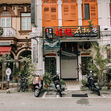Can we Design our Cities to be more Walkable?
- Shuhana Shamsuddin

- Aug 10, 2020
- 4 min read

The endeavour to understand the mode of movement for man from the earliest beginnings of life has been an interesting conundrum in many social studies. Walking has been the only proverbial mode of transportation and is commonly used for rather short trips. It is the most economical and sustainable as well as being the most preferred form of exercise apart from jogging, to keep a person fit and healthy.
However, as human progress and environmental interventions have become more incisive and extensively lateral, technology has afforded itself to address how walking can overcome distance-related movement as an issue of a practical and convenient mode of mobility. One of the major challenges in urban design especially in the developing countries is to create a walkable city, especially in the hot tropical climate places. The building of wide roads traversing the city centres and shopping malls equipped with large multi-storey parking facilities have been a favourable option to overcome the aforementioned environmental phenomenon. Whilst it is commonly accepted that cities should be walkable as urban planning policy, the environmental design of the city centre to facilitate walking still remains muted.

One of the contributing factors that are affecting our quality of life is transportation and health. It seems that the two partly goes hand in hand and that urban design has some effect on the two. There have been some notions that Malaysian urbanites prefer driving to walking in the cities. This is a convenient feign to justify using more land to building more roads at the expense of comfortable walkways in the urban areas. If such a notion is true, why do Malaysians who have travelled abroad are accustomed to enjoying walking in the city centres but cringe at the idea of doing the same here? If the heat is a factor, then, through good architecture and the creative use of landscape elements and shading devices can be used to persuade people to walk in tropical climatic conditions as evident in Southern Spain and Singapore.

Many cities in Malaysia were designed with low regards for pedestrians even though each one of us is a potential pedestrian once we get out of the cars. Even a new town like Putrajaya was not designed for walking due to the enormity in the scale of its boulevards. Hence, it is too much to expect that the older and larger cities like Kuala Lumpur to be walkable.
Can our city be walkable?
For a city in this country to be walkable, it must have at least these basic conditions: a network of pedestrian linkages in the form of sidewalks, covered walkways, five-foot walkways etc that link the major transportation hubs and nodes such as LRT stations, car parks etc to the major shopping nodes, available public places and buildings. This network must be continuous in plan and structure to enable a person to ease reachability with major areas within the central business district.
Climate responsive design

Secondly, the pedestrian linkages must be sheltered from the elements during the hot spells and heavy showers. This is when a good urban design comes into play when the streets and the buildings are designed to accommodate such conditions.
Eyes on the Streets

The third condition is safety whilst walking where it invokes both the perception of safety and the physical conditions that promote safety. Petty crimes such as pickpocketing and handbag snatchings are often associated with pedestrians and the design of streets must allow maximum surveillance on the streets through the appropriate activities allowed at the ground levels. Creative design of the transition spaces and elements between the streets and the pavements can discourage motorcyclists from pushing their machines motorcycles up the kerbs etc which in some ways may help to deter crimes from happening on the streets.
Universally-Designed for All

Accessibility is the other issue of safety for those with disabilities who tempt to cross the streets efficiently and safely. Very often we see the pedestrian paths as not accessible-friendly to wheelchairs and strollers due to unsafe detail design of kerbs and ramps. The situation gets worst in the historical parts of the city where a change of levels of the arcaded walkways was not designed to be safe even for an able-bodied person.
A Good Looking Street is a Wonderful Thing

Finally, to all intents and purposes, a street is not walkable if it doesn’t provide an interesting experience to the pedestrian walking through it. A careful study of the activities occurring along a street, its special character and functionality are needed to ensure that the streets will be used when they are enhanced before any attempts to invest time and energy on street enhancement programs. This is then followed by an urban design masterplan of the high streets of the city centre. Beautification of the streets with public arts and landscaping can also be done in such streets as part of the urban design masterplan strategies.
It is hoped that if we are going to give back the city to the people, making the streets walkable and enjoyable spatial experience in the city centre should be a priority. The stress of finding a parking space, traffic congestion and anxiety out of not able to walk during bad weather can be alleviated through good urban design solutions. If we are serious about promoting sustainable cities, then we have to start thinking of giving back the streets to the pedestrians by designing them as shared spaces with the vehicles. Lowering the carbon footprints as part of the planning policies such as Kuala Lumpur can be achieved through this urban design solution. This concept has long been practised in the developed countries and it is about time we try to make it work in our city centres.











Comments